Interlocking Driveway Cost in Ontario 2025
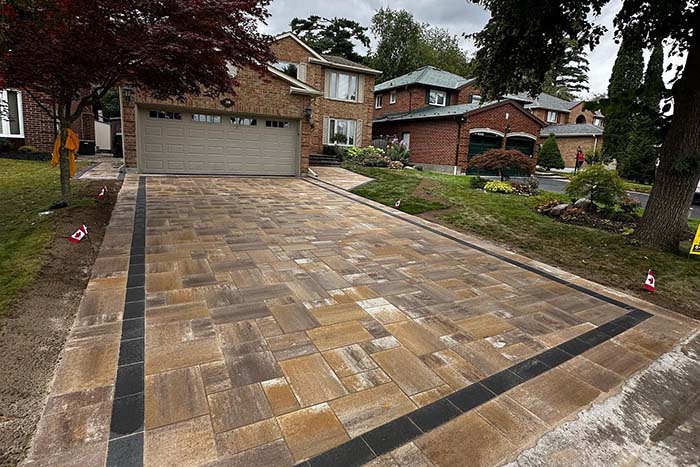
Interlocking pavers are a perfect option to enhance your outdoor space’s curb appeal and functionality while ensuring durability and a stunning look. We’ve prepared a guide to the interlocking driveway cost to help you make the best choice for your landscape projects. Budgeting for an Interlock Driveway In Toronto The first place to start when planning is budgeting. The cost of an interlocking driveway can vary depending on the area’s square footage and the materials used. Therefore, it’s essential to determine how much you are willing to spend on your new driveway, as well as do some research to decide what style and type of driveway pavers will best suit your project and budget. To make the planning process easier, let’s take a closer look at interlocking cost factors so you can fulfill all your landscaping needs within a reasonable price range. Key Factors Affecting Interlock Driveway Cost in GTA Several aspects may affect the overall cost of an interlocking driveway project. At the same time, you can get a detailed quote for installing interlocking pavers by getting in touch with the contractor, as the range may vary. Generally, when planning your project, consider the following factors: Size of Project This is the key to the interlock installation cost. The larger the driveway size, the more pavers per square foot will be needed, and the more labor resources it’ll require from the interlocking contractor. Take measurements to understand how many interlocking stone pavers per sq ft you may need. Stone Used Typically, the choice of materials to interlock driveways is between manufactured and natural stone. Each has its features and advantages. However, natural stone or flagstone costs more than manufactured pavers, concrete, asphalt, etc. Consult with the interlock contractor regarding material cost before starting the project. Location Another aspect affecting driveway cost is location, or how easy it is to access a main road. A convenient location leads to lower costs since it’s easier to deliver heavy equipment. During the site inspection, your contractor will be able to provide more information about the cost to install a new interlock driveway. Average Cost of an Interlock Driveway in Toronto The average price for interlocking driveways typically ranges from $7,000-12,000 per project; however, the cost may vary depending on the size of the area, the need to remove existing pavement, drainage work, pattern complexity, and so on. In addition to project complexity, material choice plays a significant role. For example, you can expect the following price range per sq ft: Natural stone interlocking costs $12-22 per square foot Cement interlocking costs — $5-10 per square foot Interlocking brick driveway cost — $6-12 per square foot Permeable stone pavers — $8-15 per square foot Including labor to install driveway interlocking pavers, the cost range is from $15 to $30 per sq ft. Frequently Asked Questions about the Cost of an Interlocking Driveway Is interlocking expensive? Using interlocking stone in a project is more expensive than cement or asphalt driveways; however, due to the visual appearance and durability, as well as easy maintenance, the decision to use paving stones is profitable in the long term. How long does an interlock driveway last? Paving stones are among the best solutions in terms of durability. The stone has a long service life, withstands foot traffic, and is easy to maintain, so such a driveway will serve without any problems for 30-50 years. How much does it cost to seal an interlock driveway? The sealant and cleaning method should be considered first. Typically, the cost varies between $1 and $3 per square foot. At the same time, considering the benefits of sealing, such as protection from UV rays, vehicle fluids, water, etc., it is an excellent investment in the longevity of your driveway.
How Much Does a Concrete Driveway Cost in 2025
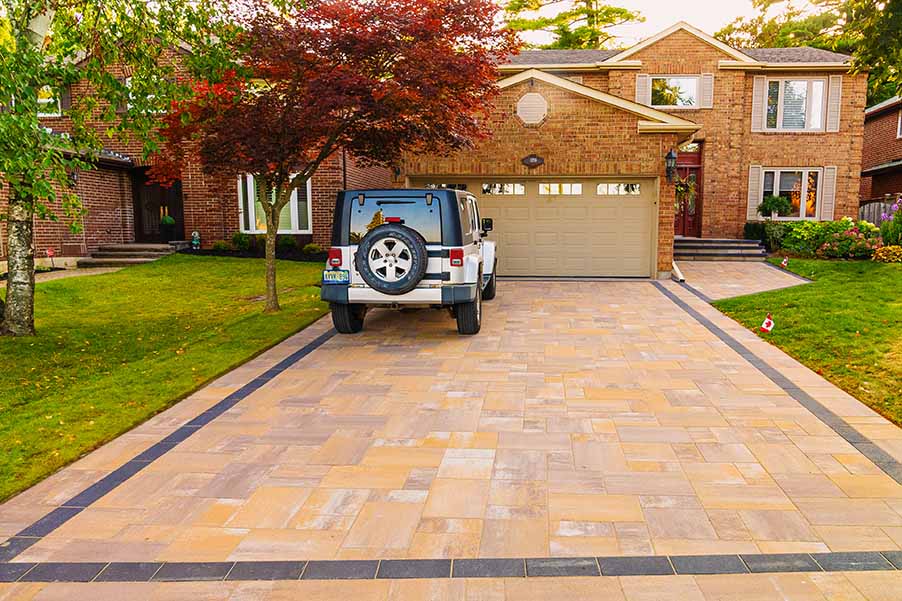
A concrete driveway increases a home’s curb appeal and functionality. With its durability and low maintenance, a decision to install a concrete driveway is a good investment in the long run. Explore Ontario concrete prices in our comprehensive guide. Budgeting for an Interlock Driveway In Toronto The first thing that starts any concrete driveway project is budget planning. Depending on several factors, the cost of concrete driveways can vary; this is influenced by project size, choice of materials and labor costs, as well as additional features and decorative finishes. Therefore, it’s worth familiarizing yourself in advance with the pricing for concrete driveway installation in Ontario and getting in touch with local contractors to get a more detailed estimate for your square footage, which will approximately correspond to the final cost. This approach allows you to properly plan your budget and choose the best options for materials and style for your new concrete driveway. Typically, the price of driveway installation ranges from $15 to $50 per square foot. Main Factors that Impact the Concrete Driveway Price The main aspects of concrete driveway cost that you should consider first when you are planning to start a project with concrete contractors in Toronto include the following factors: Size of Project Larger driveways require more materials per square foot, as well as labor and time. Additionally, such aspects as decorative elements, premium features, removal of old driveway, pre-preparation of the ground, etc., affect the total cost. Contact our interlocking contractor to get an accurate estimate for your concrete driveway project. Location Another factor in concrete driveway cost is your location, namely the accessibility of your property to major roads, since the pouring concrete process and installation work require heavier vehicles. Also, you may pay more for professional installation in urban areas due to higher demand. Average Cost of a Concrete Driveway in Toronto One of the aspects that should be given attention is the type of your driveway. In other words, the average price can vary depending on whether it is a large but simpler driveway or a smaller but more customized driveway: Large yet simpler driveways with classic designs may cost around $15 per square foot (perfect if you are seeking functionality, basic broom-finished concrete surfaces or spacious driveways) Small yet more sophisticated driveways with custom design may cost around $50 per square foot (perfect if you want to add premium features, concrete patterns, exposed aggregate finishes, colored concrete options, etc.). Another factor is single or double concrete driveway. Thus, the overall cost of a single driveway project is in the range of $13,000-15,000, and a double driveway is $15,000-25,000. In addition, we recommend familiarizing yourself with the following aspects: The cost of concrete contractors’ services is 10-15% higher in the Greater Toronto Area (GTA) and Ottawa than in Hamilton/Burlington or rural Ontario. The cost of the project can vary significantly based on additional features. For example, a heated driveway adds $12-18 per sq ft, sealer application $0.50-1.50 per sq ft, custom color integration $3-7 per sq ft, border design $3-8 per linear ft. Learn more about the cost of concrete driveways in Ontario by contacting us. Frequently Asked Questions about the Cost of an Interlocking Driveway Is a concrete driveway cheap? Concrete driveways are a less expensive option than natural stone, for example. This is a more affordable choice that is durable, cost-effective, and easy to repair, as well as perfect for customization to enhance aesthetic appeal and increase home value. Is a concrete driveway cheaper than paving? Yes, concrete is more affordable than many types of pavers, which can cost $20-$25 per square foot or more, depending on the material and the complexity of the project. So, if you are looking for an alternative to pavers, a concrete driveway is a great option. What is the life expectancy of a concrete driveway? Life expectancy may vary depending on weather conditions in your area, traffic and loads, use of protective sealants, etc. Typically, concrete driveways will provide a lifespan of 20 years or more when properly maintained.
How Much Does Interlocking Cost? Understanding the Factors That Affect the Price of Interlocking
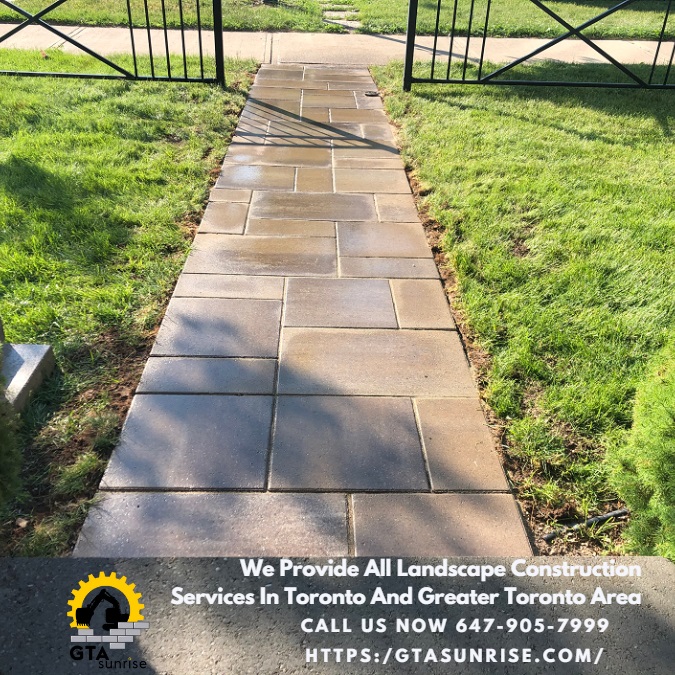
Have you ever considered the cost of paving your driveway or patio with interlocking stones? Interlocking is a cost-effective way to give your outdoor space a makeover and increase the value of your home. It can also save you time and effort on maintenance, as it requires less upkeep than other materials. But with so many options available, knowing what budget you should set aside for this project can be hard. In this article, we’ll break down the different factors that go into pricing interlocking projects and estimate what they typically cost. Interlocking is a popular choice for outdoor landscaping projects due to its durability and ease of care. With a wide range of colours, patterns, and sizes available, homeowners can find the perfect fit for their home’s style and budget. Interlocking is also eco-friendly since it doesn’t require any sealant or paint for protection against the elements. However, the cost of interlocking projects can be a concern for some. The total cost of a project depends on various factors, including size, complexity, pattern design, and labour costs. Nonetheless, there are ways to get an accurate estimate without breaking the bank. By understanding the components that make up the total cost and shopping around for competitive rates from different contractors, you can get the best deal on quality materials and installation services. In this article, we’ll cover everything you need to know about interlocking prices so you can make an informed decision when planning your next project. The cost to install interlocking pavers varies depending on the location, the type of paver used, and the company installing them. According to a few sources, installing interlocking pavers can range from $10 to $27 per square foot. However, the national average cost of installing interlocking pavers for a patio is around $3,400. The cost per square foot can also vary depending on the materials used, labour costs, permits, and inspections required. Therefore, it is recommended to get a quote from a professional contractor to obtain an accurate estimate for the installation of interlocking pavers. Definition Of Interlocking Interlocking is a construction technique used to build hardscapes, such as patios and walkways. It involves laying down individual pieces of stone, brick, or concrete in order to create a sturdy, durable surface. The pieces are designed to fit together like puzzle pieces and can be arranged in various patterns. Interlocking can be used to construct various structures, such as driveways, retaining walls, staircases, and outdoor living spaces. The cost of interlocking depends on the size of the project, the type of material used, and the complexity of the design. When it comes to materials for interlocking projects, there are many different options available. Common materials include stones like flagstone or slate; bricks; concrete pavers; or pre-cast concrete blocks. Each material possesses its own unique characteristics that will impact the total cost of your project. For example, flagstone tends to be more expensive than other types of stone because it is more difficult to install due to its irregular shape and weight. Bricks are typically cheaper than stones but require more maintenance over time compared with other materials. The complexity of the design is another factor that impacts interlocking costs. As you add more intricate elements, such as curves or steps, into your design, it will require additional time and skill from your contractor, which will increase the overall cost of your project. Similarly, choosing a large area for your project could also require extra labour, which would result in higher costs than choosing a smaller space instead. Factors Affecting Price The cost of interlocking depends on several factors. First, the type of material used to make the interlock affects the price, as more expensive materials often have higher costs associated with them. Second, the size and complexity of the interlock can also affect the price. More intricate patterns or larger areas may require more labour and materials, leading to increased costs. Finally, the location where the installation is taking place can influence how much it will cost. For example, if a professional must be hired to do the job in an area with high labour costs, this could add up quickly. All these factors should be taken into consideration when budgeting for an interlocking project. The overall cost can vary greatly depending on the type of material used, how complex and large it is, and where it’s installed. Getting quotes from multiple sources and carefully comparing them is important before making a decision about which option is best for you. DIY Costs DIY costs for interlocking can vary depending on the type of project you are doing. For a small patio, it can cost around $3 per square foot to install interlocking bricks or pavers. This cost includes materials such as the pavers or bricks themselves, sand, and gravel. The cost per square foot increases for larger projects such as driveways or walkways because of the additional materials needed. In addition to the pavers or bricks, there may also be a requirement for underlying material such as crushed stone or concrete aggregate, which increases the overall cost. For DIY projects that require specialized tools and equipment, such as those necessary for laying down a retaining wall block system, there will also be additional costs associated with renting or purchasing these items. It is possible that you will need to purchase extra materials, such as sanding sealers and edging products, in order to complete your project. The degree of difficulty of your task will also play a role in this. These items can add significantly to your overall interlocking project costs. Suppose you are considering installing interlocking in your yard yourself. In that case, it is important to do research about materials and supplies in order to get an accurate estimate of what it will cost you. You should also factor in any additional labor costs you may incur if you decide to hire someone else to help with installation or other aspects of
How Much Does a Fence Cost in Canada? A Comprehensive Guide
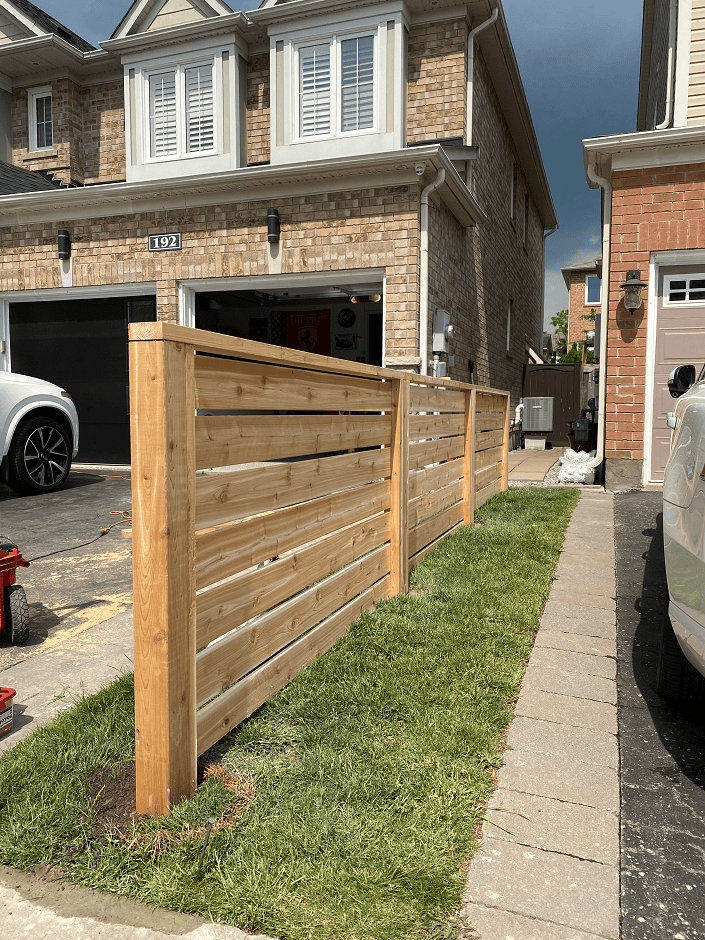
Deciding to install a new fence or upgrade an existing one involves several considerations, chief among them being the cost. “How much does a fence cost in Canada?” or “How much does a 6-foot privacy fence cost per foot in Canada?” you might ask. The answer isn’t as straightforward as a single number but varies based on various factors, which we’ll delve into in this comprehensive guide. How much is 300 feet of Fence? When looking at fence pricing, it’s common to consider the cost by the linear foot. This method provides a more accurate estimate as it takes into account the precise dimensions of your property. So, “how much is 300 feet of fence?”• 100 linear feet: $2,300• 150 linear feet: $3,600• 300 linear feet: $6,900 These prices are a ballpark estimate and may fluctuate based on factors such as materials used, complexity of fence building, and more. 6 Foot Privacy Fence Cost in Canada Fence height is one of the key factors affecting the final cost of the fence. It’s as simple as one-two-three: a taller fence means higher cost. When it comes to securing privacy for your backyard, a 6-foot fence is a popular choice among homeowners. However, “how much does a 6-foot privacy fence cost in Canada?” For a 6 Ft Builder Style Fence, prices start from $55.00/ linear ft, including 6×6 fence posts and a choice of black or copper iron post caps. Factors Influencing Fence Cost in Canada Several factors come into play when determining the overall fence cost: Material: Choices range from wood, vinyl, to metal, each with different pricing. Design: A simple design will cost less compared to an intricate, custom design. Size and Length: The larger or longer your fence, the higher the cost will be. Labor: Installation costs depend on the complexity of the project and the professional’s rate. Fence Costs by Material How much does a fence cost depending on the material? Here’s a table that provides a clear comparison of the most common materials in terms of costs: Fence Material Fence Cost per Linear Foot Fence Installation Costs per Linear Foot Chain link fences $12-$22 $5-$10 Pressure-treated wood fences $15-$30 $5-$15 Cedar fences $25-$50 $10-$20 Composite fencing $20-$45 $10-$30 Vinyl fences $30-$60 $10-$20 Aluminum fences $40-$100 $15-$30 Concrete fences $100-$175 $25-$50 FAQs on Fence Cost in Canada What’s the average cost for a new fence in Canada? The range for a fence installation can fall anywhere between $1,900 to $5,000. On average, most homeowners will spend about $3,000 for their fence, depending on the property size and fencing material. Does the cost include installation? Yes, the prices mentioned typically include labor costs. However, it’s always a good idea to confirm this with professional fence contractors. How can I reduce my fencing costs? Selecting a simple design, choosing affordable materials, or even installing the fence yourself can help reduce overall costs. Conclusion Understanding “how much a fence costs in Canada” requires careful consideration of various factors, such as the type of fencing material, fence height and length, labor costs in your region, and additional features like gates or decorative fence elements. If you’re replacing an old fence, the cost of your old fence removal and disposal can also add a notable amount to the total cost. Although it might seem daunting initially, this guide should help you navigate the pricing landscape more confidently. Remember, investing in a high-quality fence is not just about marking your property; it’s about ensuring privacy, security, and enhancing your home’s curb appeal.
How much does snow removal cost?
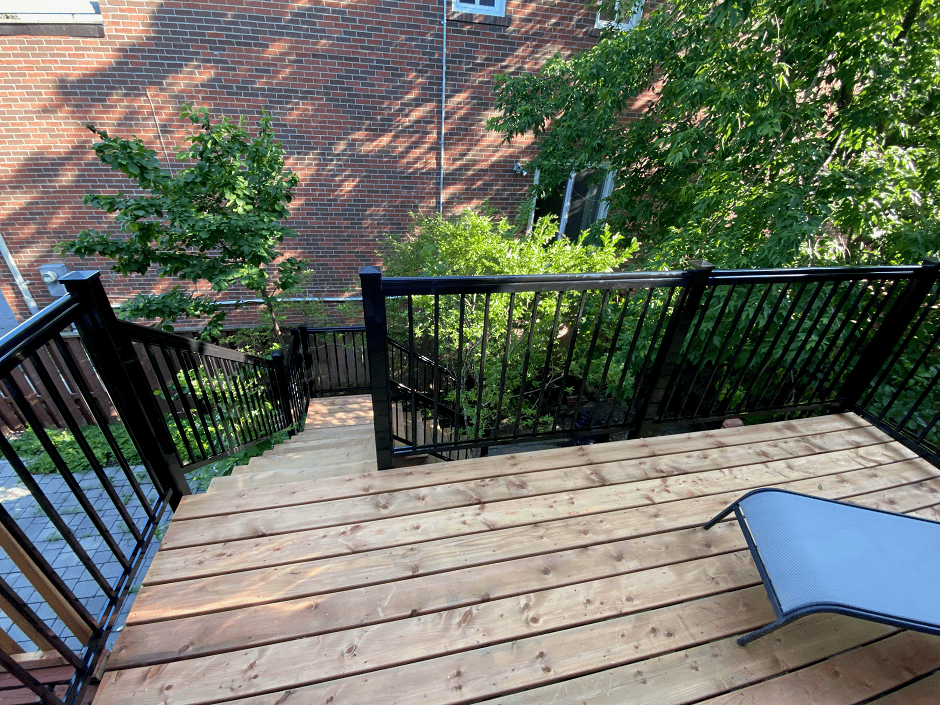
Introduction When the snow season begins, it’s essential to clear the snow from the front areas of residential and commercial properties using specialized equipment, so you likely need to hire a snow removal service. Snow removal in Toronto prices So, what are snow removal Toronto prices? It is important to highlight that there is no fixed hourly rate; each company offers its own price. The cost of snow removal services usually depends on location, ice and snow levels, equipment, and many others. Usually, professional snow removal services charge between $40 and $150 per visit or $290–1,100 per seasonal contract. To determine a more accurate price of snow plowing in Toronto for your property, consider several aspects. Key factors affecting snow removal costs in GTA Snow removal in Toronto is a high-demand service during the snow season. How much does snow removal cost? Well, it depends on a range of factors, so let’s check them out and get ready for the winter weather. Area size (driveways, walkways, etc.) Snow plowing and snow shoveling prices depend on the property size and the area that requires deicing. It takes more time to clear snow from a longer driveway or interlocking walkway. So, the bigger the area for maintenance is, the more the snow removal company will charge you. Snow and ice levels When calculating snow removal cost in Toronto, consider typical snow patterns of your location as well as snow and ice levels. Areas covered with a thick layer of ice and snow require proper equipment for clearing. Removing a heavy coating of ice is also time-consuming, so it might incur additional fees. Equipment and frequency of service The use of specific snow removal equipment (snow blowers) and chemicals (rock salt) influences the price of snow removal services. Most snow removal companies offer seasonal contracts specifying service frequency, which usually lowers the average snow removal cost. Take into account typical snowfall patterns when choosing the frequency of service. Location To estimate the price of their snow removal services, companies consider many factors, and the location of your commercial or residential property is among them. The greater the distance snow removal workers have to travel to your place, the higher the service costs, so consider this factor when choosing a company. Residential vs. commercial snow removal services Snow removal in Toronto for residential properties is usually cheaper than the same services for commercial properties. This is because сommercial snow removal often requires the use of extra equipment, like snow blowers, and services, like roof snow removal. Moreover, residential snow removal services are safer to perform and not as time-consuming as commercial ones. Therefore, they are less expensive than commercial snow removal services. The advantages of having a snow removal plan To prevent ice buildup on your driveway and reduce the risk of slips and falls, make sure to regularly clear ice from your property. Given that, the best snow removal strategy involves seasonal contracts, i.e., hiring a snow removal company to take care of deicing your walkway and driveway on a regular basis. A proactive snow removal plan not only ensures the safety of residential and commercial properties but also enhances their appearance. Your business, especially a restaurant or a store, will stand out from others and definitely capture attention, which can go a long way toward attracting customers in the cold season. Please remember that the factors listed in this article influence both seasonal and occasional snow plowing costs. We recommend choosing companies with strong reputations to avoid hidden fees. Frequently asked questions about snow removal price Are there discounts for signing up for snow removal plans in advance? Almost every snow removal company offers seasonal contracts, specifying how often employees will visit your residential or commercial property to provide professional services. Usually, businesses offer discounts for seasonal contracts. If it frequently snows in your area, it’s more cost-effective to sign up for a snow removal plan. How much does snow removal cost per hour? The average hourly rates range from $25 to $80. Please note that the rate can vary based on the size of the company, frequency of services, type of equipment, etc. You can always ask a snow removal company for a free estimate. What additional fees should I expect when hiring a snow removal company? When determining how to price snow removal assistance, companies that offer snow removal services consider deicing, roof snow removal, ice control, or other extra work. All this impacts snow plowing costs and may incur additional fees. Some companies may also charge extra for using additional equipment or spending extended time at your property. How much does snow removal cost per season? Usually, costs vary from $200 to $630 per month, so, given that the snowy season lasts from November through March in GTA, be ready to spend $1,000–3,150 per season.
How Much Do Bin Rentals Really Cost?
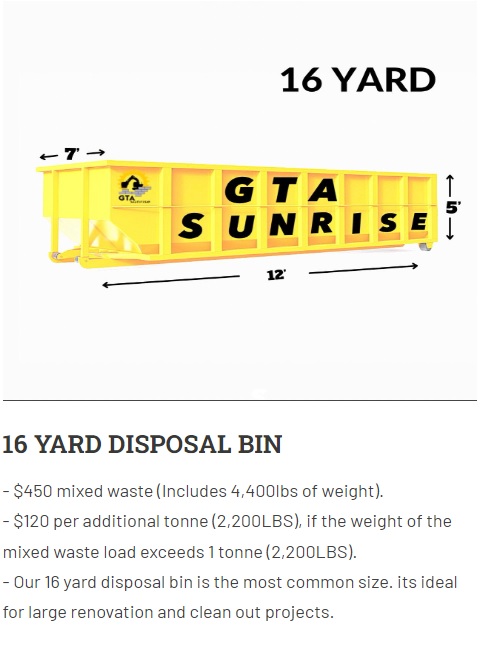
When it comes to clearing out waste or managing large-scale disposal tasks, bin rentals can be a real lifesaver. Whether you’re undertaking home renovations, organizing a community event, or handling commercial waste, understanding the cost of bin rentals can be essential for budgeting. In this article, we’ll break down the expenses and offer some pointers on making the most out of your bin rental. Factors That Influence Bin Rental Prices Types of Bins Available for Rent Tips to Save on Bin Rentals How much is the smallest dumpster to rent? Renting a 4-yard disposal bin, which measures approximately 6 feet wide, 4 feet long, and 4 feet high, is ideal for smaller waste management tasks such as garden clean-ups or minor renovations. The cost of renting this compact dumpster varies based on factors like the rental duration, geographic location, type of waste, and additional services requested. Its compact size means it’s space-efficient, often more affordable for small projects, and easier to load due to its lower height. Before securing a rental, it’s essential to confirm all costs and understand the rental agreement to ensure you’re receiving the best value for your needs. What is the most common dumpster rental? While the 20-yard dumpster is frequently recognized as the most common rental size for substantial waste management needs, “GTA Sunrise” offers a competitive alternative with its 16-yard disposal bin. Priced at $450 for mixed waste, this rental includes a hefty 4,400 lbs of weight. Should your mixed waste exceed this by 1 tonne (2,200LBS), an extra charge of $120 per additional tonne will apply. The 16-yard bin from GTA Sunrise stands out not just for its cost-efficiency but also for its adaptability. It’s the preferred choice for many, proving ideal for sizable renovations and comprehensive cleanout tasks. Whether you’re refurbishing an entire home or tackling a significant decluttering project, this bin offers both space and value. FAQs How long can I keep a rental bin? This depends on the company, but typically rentals are available for daily, weekly, or monthly durations. Are there items I can’t dispose of in a rental bin? Yes, items like batteries, paint, and other hazardous materials might be restricted. Do companies offer pick-up and drop-off services? Most bin rental companies include delivery and pick-up in their services, but always check to be sure. Final Thoughts Bin rentals can be a versatile solution for a range of waste management needs. Understanding the factors that influence their costs and being aware of the types of bins available can help you make informed decisions. Remember, it’s not just about finding the cheapest option but the one that offers the best value and meets your specific needs.
Affordable and Low-Maintenance Landscaping for Beginners in Toronto
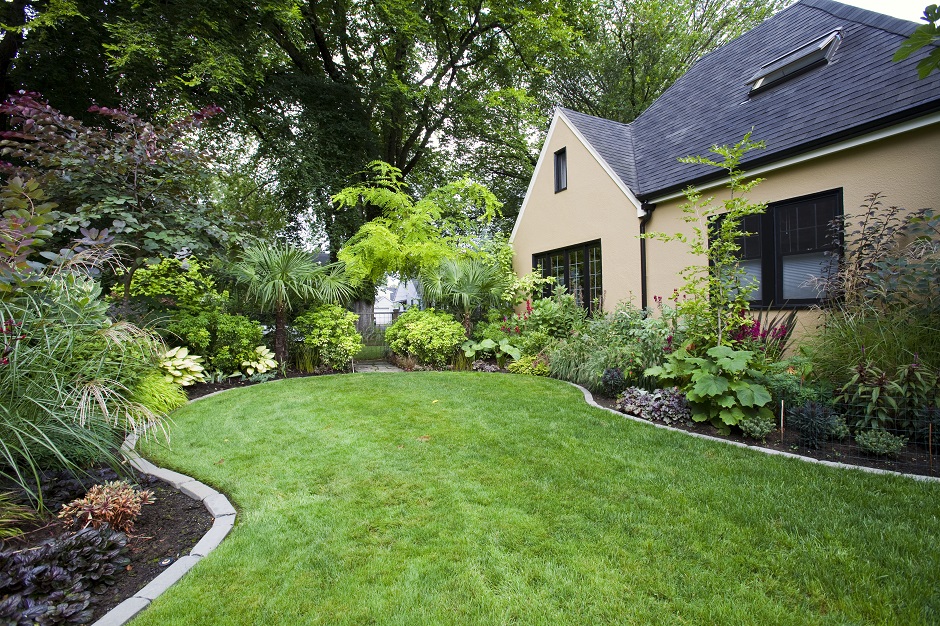
Landscaping is an essential aspect of home improvement and can transform your outdoor living space into a beautiful and functional haven. Choosing the right type of landscaping can be overwhelming, especially if you’re on a budget or a beginner. In this article, we’ll discuss the cheapest type of landscaping and how to choose and maintain them easily. If you are looking for expert Toronto landscaping contractors – contact us today! What is the cheapest type of landscaping? The most affordable landscaping option is often referred to as “do-it-yourself” (DIY) landscaping. This approach involves using low-cost and easy-to-maintain plants, materials, and techniques to create a visually appealing space. Native plants, mulch, and recycled materials are some of the cost-effective elements you can use in your affordable landscape project. What are the 5 types of a landscape? The main types of landscapes include: 1. Formal Landscapes: These are characterized by symmetrical designs, well-defined lines, and geometric shapes. 2. Informal Landscapes: These have a more relaxed and natural feel, with curved lines and an emphasis on native plants. 3. Japanese Landscapes: These focus on balance, harmony, and simplicity, often incorporating water features and Zen gardens. 4. Xeriscapes: These are designed for water conservation, utilizing drought-tolerant plants and efficient irrigation systems. 5. English Gardens: These feature lush and colourful plantings, meandering paths, and a variety of traditional garden elements. How do I choose an affordable landscape? To choose the right landscape for your property, consider the following factors: 1. Climate: Select plants and materials that are suitable for your region’s climate and soil conditions. 2. Maintenance: Consider the time and effort required to maintain the landscape, opting for low-maintenance options if necessary. 3. Budget: Determine your budget and prioritize cost-effective solutions that meet your aesthetic and functional needs. 4. Personal Style: Choose a landscape design that reflects your personality and complements your home’s architecture. How do an affordable landscaping for beginners? Beginner-friendly landscaping tips include: 1. Start small: Begin with a small area to avoid being overwhelmed and gradually expand your project. 2. Choose low-maintenance plants: Opt for native and drought-tolerant plants that require minimal care. 3. Plan ahead: Sketch out your landscape design and consider factors such as sunlight, drainage, and plant growth. 4. Mulch and compost: Use organic mulches to suppress weeds and improve soil health and compost to nourish plants. What is a realistic landscape budget? A landscaping budget can vary greatly depending on the project size, materials, and labour costs. For a basic landscape makeover, a budget of $15,000 to $150,000 or more can be expected. To save money, consider affordable landscaping, reusing materials, and prioritizing cost-effective elements. What is the lowest maintenance landscaping? To create a low-maintenance landscape, consider implementing the following strategies: 1. Use native plants: These are well-adapted to your local environment, requiring less water, fertilizer, and overall care. 2. Install automatic irrigation systems: These ensure your plants receive the right amount of water without manual intervention. 3. Limit lawn areas: Replace large lawns with ground covers, mulch, or hardscape materials to reduce maintenance. 4. Employ natural pest control: Introduce beneficial insects. What should be the landscape budget? The 10% rule is a common guideline when determining a landscaping budget. For a $400,000 home, allocating $40,000 for landscaping is a reasonable approach. Remember that this is just a guideline, and the actual budget can vary depending on the complexity of the project, materials used, and labour costs. Always consider your specific needs and financial situation when planning your landscaping project. Discover how to create the perfect outdoor oasis with our comprehensive guide on affordable and low-maintenance landscaping. Serving Toronto, Markham, Richmond Hill, Vaughan, North York, Scarborough, and the surrounding areas in GTA, don’t miss out – “GTA Sunrise” today and transform your backyard into a stunning retreat that suits your budget and lifestyle. Contact us now.
The 5 Methods of Waste Disposal: Understanding Your Options
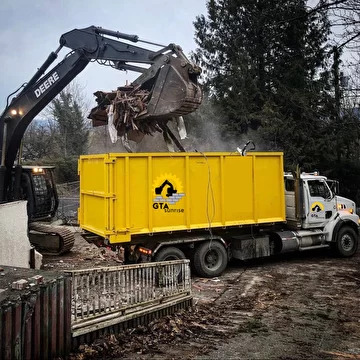
Effective waste management is essential for a healthy environment and sustainable living. This article will examine the five methods of waste disposal and address some frequently asked questions about garbage cans, including their function and various types. 1. Landfills: This method involves burying waste in designated areas, which are then covered with soil. While landfills are cost-effective and simple to maintain, they can contribute to greenhouse gas emissions and groundwater contamination if not managed properly. 2. Recycling: Recycling involves the collection, processing, and repurposing of waste materials into new products. This method conserves natural resources, reduces pollution, and helps decrease the need for landfills. 3. Composting: Composting is a natural process of breaking down organic waste into nutrient-rich fertilizer. This technique is perfect for getting rid of waste from the garden and the kitchen, and it has the potential to dramatically cut down on the amount of rubbish that is sent to landfills. 4. Incineration: Incineration involves burning waste at high temperatures to convert it into ash, gas, and heat. While this method can help reduce waste volume, it may produce harmful emissions if not regulated properly. 5. Waste-to-Energy: Waste-to-energy plants convert waste into energy, such as electricity or heat. This method not only reduces waste volume but also provides an alternative energy source. What is the Meaning of Disposal Bin? A disposal bin, also known as a dumpster or waste container, is a large, sturdy receptacle designed to temporarily hold and store waste materials until they can be transported to a waste disposal facility. How Big is a 12-Yard Bin? A 12-yard bin typically measures around 12 feet long, 8 feet wide, and 4.5 feet high. It can hold up to 12 cubic yards of waste, which is equivalent to approximately 90-100 standard trash bags. What is the Purpose of a Disposal? The primary purpose of waste disposal is to manage and dispose of waste materials in a manner that is safe, environmentally friendly, and efficient. Proper waste disposal helps protect public health, conserve natural resources, and reduce pollution. What are the 3 Types of Bins? 1. Recycling bins: These bins are used to collect recyclable materials, such as paper, plastic, glass, and metal. They are often colour-coded to help users differentiate between various types of recyclable materials. 2. Organic waste bins: Organic waste bins are designed for compostable materials, including food scraps, yard waste, and biodegradable products. These bins help divert organic waste from landfills and promote composting. 3. General waste bins: General waste bins are used for non-recyclable and non-compostable waste materials. This type of bin is intended for materials that cannot be processed through recycling or composting methods. Understanding the various methods of waste disposal and the importance of disposal bins can help us make informed choices when it comes to managing our waste. By adopting responsible waste disposal practices, we can contribute to a cleaner, healthier environment for future generations.
Discover the Ideal Retaining Wall Solution with GTA Sunrise
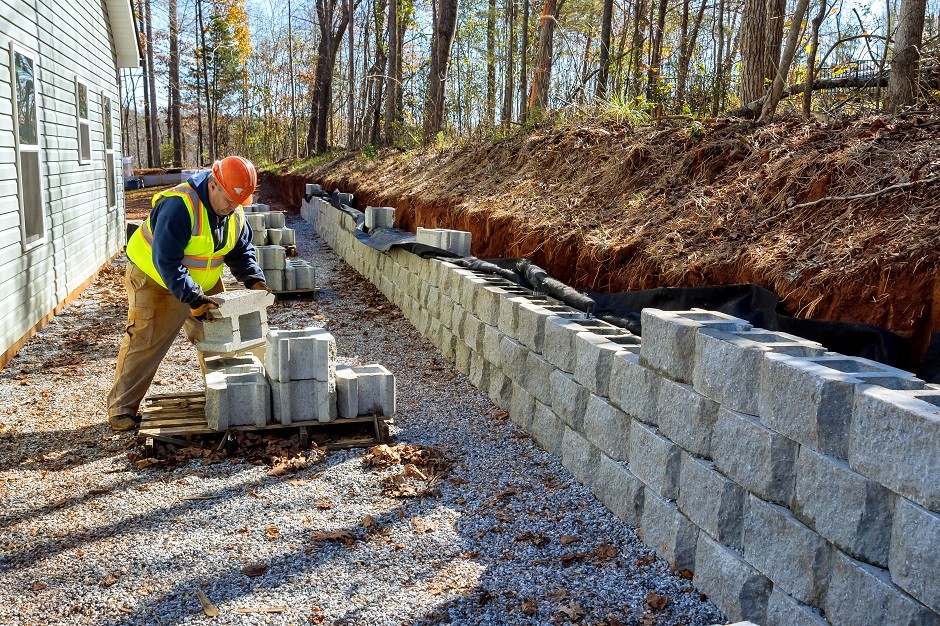
Retaining walls serve multiple purposes, from preventing soil erosion to enhancing the aesthetics of your outdoor space. With various materials and designs available, it’s crucial to select the right retaining wall for your specific needs. At GTA Sunrise, we’re dedicated to helping you make informed decisions. Let’s explore the answers to some common questions about retaining walls: What type of retaining wall is best? The ideal retaining wall depends on factors such as location, soil type, and load-bearing requirements. Common types include gravity, cantilever, sheet pile, and anchored retaining walls. Consult with a professional at GTA Sunrise to determine the best solution for your property. Which retaining wall material is the most cost-effective? Timber and dry-stacked stone retaining walls are often the most cost-effective options. However, their durability and longevity may be limited compared to other materials. For a perfect balance between affordability and durability, consider a concrete block retaining wall. What is the strongest material for a retaining wall? Concrete and reinforced concrete are among the strongest materials for retaining walls. They offer excellent load-bearing capacity, long-lasting durability, and resistance to environmental factors. Contact GTA Sunrise to discuss which material is best suited for your project. What is the most stable wall? The stability of a retaining wall depends on factors such as design, material, and construction quality. Properly designed and constructed gravity walls, cantilever walls, and geogrid-reinforced walls tend to be highly stable. Consult with our experts at GTA Sunrise to ensure you choose a stable and durable retaining wall for your property. What is the best retaining wall to prevent erosion? Vegetated and gabion retaining walls are particularly effective in preventing erosion. Vegetated walls incorporate live plants, promoting natural root systems to stabilize the soil. Gabion walls use wire mesh baskets filled with stones, allowing water to flow through while preventing soil erosion. Speak with a specialist at GTA Sunrise to select the best erosion-preventing retaining wall for your landscape. At GTA Sunrise, we’re committed to providing you with the highest quality retaining walls and expert guidance for your landscaping needs. Contact us right away to talk about your plans and find the ideal retaining wall for your home.
Elevate Your Outdoors: Mastering the Art of Lighting Landscape
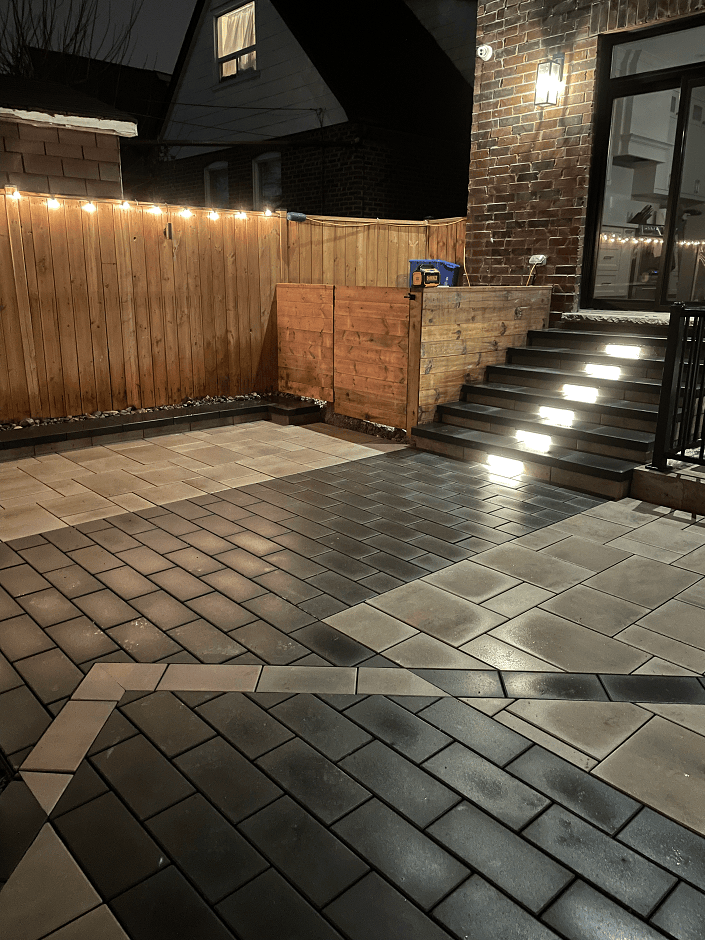
In the symphony of design, lighting plays the conductor, seamlessly tying together aesthetics and functionality. It breathes life into our surroundings and sets the tone for our mood. When this practice extends beyond the confines of indoor spaces, we enter the realm of landscape lighting. Landscape lighting is a fascinating fusion of art and technology that, when done right, can transform a simple backyard into a magical outdoor haven. From low voltage landscape lighting to solar-powered alternatives, the choices are as diverse as the landscapes they illuminate. This comprehensive guide will walk you through the essentials of lighting landscapes, from the frosty corners of Canada to tropical paradises worldwide. Transforming Night into Art: The Basics of Landscape Lighting Landscape Lighting: A Primer Landscape lighting is a fine balance of practicality and aesthetics. It provides safety and navigation, meanwhile creating an enchanting aesthetic that complements your landscape’s features. Embrace Low Voltage Landscape Lighting Low voltage landscape lighting is a popular choice due to its safety, energy efficiency, and ease of installation. It operates on a mere 12 volts compared to the 120 volts of a standard home outlet, reducing energy costs and promoting environmental sustainability. The Canadian Approach to Landscape Lighting In Canada, landscape lighting must navigate diverse terrain and withstand seasonal extremes. Incorporating energy-efficient, durable options like LED lights ensures functionality, regardless of weather conditions. Creating a Symphony of Light: Design Strategies Form Follows Function Start with highlighting essential areas like walkways, entrances, and architectural elements. Make these areas the foundation of your lighting plan. Balance and Harmony In landscape lighting, less is often more. Create balance by evenly distributing light and avoiding overlighting to maintain a sense of natural ambiance. A Canadian Perspective: Illuminating Four Seasons Canada’s landscape offers four distinct seasons, each with unique lighting opportunities. Warm, inviting lights can cozy up a winter landscape, while softer lighting can add to the joy of a summer evening. Choosing the Right Fixtures: A Guide to Landscape Lighting Hardware Spotlights and Path Lights Spotlights are versatile fixtures that accentuate features, while path lights guide the way in dark areas. Deck and Step Lights These fixtures provide safety on your deck or stairs, and their low-profile design doesn’t detract from your landscape’s natural beauty. Landscape Lighting in Canada: Resilience and Efficiency In Canada, choose fixtures that withstand harsh weather conditions. Opt for LED lights for their longevity, efficiency, and their ability to function in cold temperatures. Frequently Asked Questions What is the best landscape lighting? The best landscape lighting depends on your specific needs. Low voltage landscape lighting is generally recommended for its safety and energy efficiency. How to install landscape lighting? Installation varies based on the type of lighting. However, most low voltage systems can be installed with basic DIY skills. What are the landscape lighting options in Canada? Canadian landscape lighting options range from solar, LED, to low voltage systems, all designed to withstand diverse weather conditions. Conclusion Lighting landscape is not just about visibility; it’s about creating an ambiance that extends the comfort of your home to the outdoors. As we’ve explored, the perfect landscape lighting balances aesthetics, functionality, and sustainability. Whether you’re illuminating a small garden in suburban Canada or a sprawling estate elsewhere, the principles remain the same. With the right approach, you can transform your outdoor space into a magical nighttime wonderland that enchants all who enter.